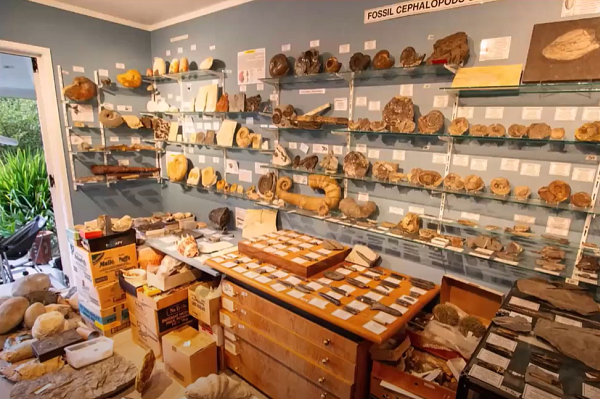Our annual online Vernon User Group (VUG) meeting was held in October and featured presentations from several institutions in New Zealand and Australia about diverse topics – everything from entire museum collection moves and fossil accessioning to archaeology artefacts and managing risk and hazard information.
Five years online
Our Vernon User Group (VUG) has had an online meeting every year for five years now.
In 2020, when the world locked down in response to Covid-19, we swiftly moved to an online format for the first time. Now that we are back to having in-person meetings in NZ and Australia each year, we’ve shortened the length of VUG Online but kept it absolutely free. All the presentations are recorded and published on our public YouTube channel so you can watch anytime.
I have attended these for the past few years and always find them very useful and informative. The online format is useful so we get to hear from our Australian counterparts and also makes it easier to attend during busy work days. Balancing this with in-person workshops throughout the rest of the year is a good balance, I think. Thank you again – as always it was great
Vernon User Group feedback
Company update
The meeting kicked off on Wednesday 16 October with a presentation from our CEO, Paul Rowe about the latest developments in Vernon CMS and Vernon Browser.
Our latest version is Vernon CMS 12.5 (Eager Egret). Key features are improvements to the Person file and XML Import tool. We’re working to introduce a new Call Number field and Series Title field, as well as bulk-delete functions. For more information, see our Roadmap.
We’ve also improved the Vernon CMS Help website.
Canterbury Museum redevelopment
Scott Reeves, registrar, and Kristen Ramsdale, collection inventory project manager shared their work on the Canterbury Museum redevelopment and other developments. As part of this significant project, the team packed, tracked, and relocated 2,300,000 items.
Complex moves included a blue whale skull, several large waka, and delicate bird specimens. The team used Kiwi ingenuity to source local packing products and avoid waste. Incredibly detailed planning ensured that every item was protected, secured, and traced. The entire collection was held in one huge warehouse, shown in the presentation with a video recorded by drone.
Canterbury’s talk was very interesting, particularly their approach of tracking shelves not objects to make things easier and the drone shot was also very cool.
Vernon User Group feedback
For more information, visit www.canterburymuseum.com/redevelopment.
Fossil accessioning
Jon Primmer, Haylee Alderson, and Caleb Maher from Waikato Museum talked about their process in accessioning a fossil collection. A local collector had sadly passed away and his family wanted to fulfil his wish to give his collection to the public. The wonderful collection of fossils included moa bones, shells, wood, ferns, ammonites, and belemnites.
This project was like a microcosm of all the considerations they normally have to take but all at once. It was a good test of their collections policy and procedures. Some items were well-labelled while others were not. The team used the XML Import spreadsheet to record and track data about each fossil, including field collection reference, place description, and stratigraphy context.
It was all interesting and a great way to see what’s happening at other institutions!
Vernon User Group feedback
Digital objects and time-based media
Within collections, we’re increasingly dealing with objects where the original form is digital. While these will often be digital media files, the concept also covers other born-digital materials such as websites, email correspondence, and electronic records.
On the second day of the event, Paul gave an overview of digital preservation and showed how you can record digital objects and time-based media in Vernon CMS.
Archaeological rationalisation project
Deb Waddell and Magella Kerr from the City of Parramatta shared how they use Vernon to manage data about archaeological artefacts. The rationalisation project consisted of four phases: record creation, artefact appraisal, digital and physical management, and their online presence.
The cultural collections team manages a vast archaeology collection consisting of around 120,000-150,000 artefacts stored in over 4,500 archive boxes. This includes 20 unique historical assemblages from excavation sites. The team’s goal is to have an Object record in Vernon with a photograph for every artefact. They then use an appraisal matrix to determine each artefact’s suitability for display, research, outreach, dispersal or disposal. A range of Vernon tools is used to manage the recording, importing, and updating of data.
I enjoyed the presenters from Parramatta. My kind of people!
Vernon User Group feedback
Hazard and risk in Vernon CMS
Megan Harvey, collection manager at Auckland War Memorial Museum, describes her process for improving risk and hazard data in Vernon CMS. The museum has around 5-6 million objects across natural sciences, human history, and documentary heritage.
Risk and hazard information is recorded in two tables: Risk to Object and Hazard in Object. The authority terms available for the Risk Type and Hazard Type fields are held in one authority file in Vernon, the Risk/Hazard Type file. The terms within this file were reviewed, researched, and enhanced to allow clearer data entry and recordkeeping. A hierarchy of terms was carefully planned and developed that aligns with HSNO and WorkSafe requirements. The team uses the one line display on Object records to indicate each item’s hazard status.
Auckland Museum’s talk was very helpful as we are looking to start a similar project so it was great to hear their approach and I’ve already been in touch with Megan as a result.
Vernon User Group feedback
Learn more about Vernon CMS
- Create or update records in bulk with XML Import
- Authority terms
- Import and link images in bulk
- Risk Type and Hazard Type fields


[…] Read about VUG Online and watch the videos […]